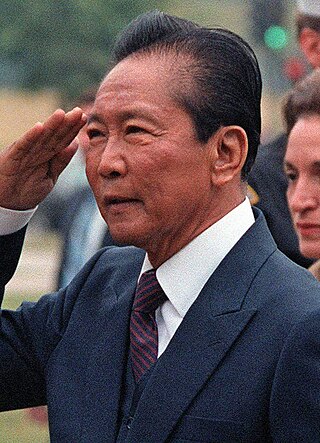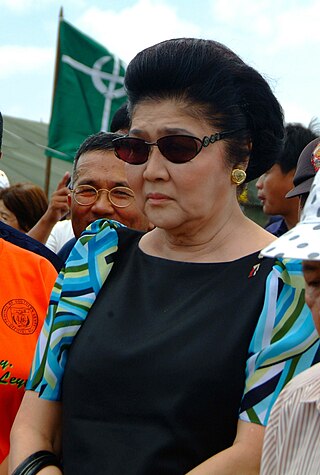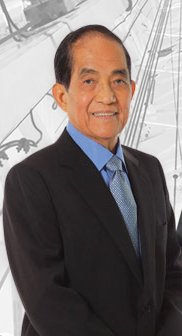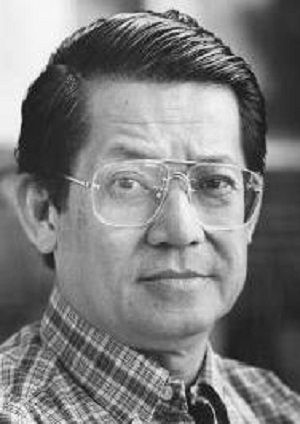Related Research Articles

Ferdinand Emmanuel Edralin Marcos Sr. was a Filipino politician, lawyer, dictator, and kleptocrat who was the 10th president of the Philippines from 1965 to 1986. He ruled under martial law from 1972 until 1981 and kept most of his martial law powers until he was deposed in 1986, branding his rule as "constitutional authoritarianism" under his Kilusang Bagong Lipunan. One of the most controversial leaders of the 20th century, Marcos's rule was infamous for its corruption, extravagance, and brutality.

The Philippine peso, also referred to by its Tagalog name piso, is the official currency of the Philippines. It is subdivided into 100 sentimo, also called centavos.

Imelda Romualdez Marcos is a Filipino politician who served as the First Lady of the Philippines from 1965 to 1986, wielding significant political power during the dictatorship of her husband, 10th president Ferdinand Marcos. She is the mother of current president Bongbong Marcos.

Binondo is a district in Manila and is referred to as the city's Chinatown. Its influence extends beyond to the places of Quiapo, Santa Cruz, San Nicolas and Tondo. It is the oldest Chinatown in the world, established in 1594 by the Spaniards as a settlement near Intramuros but across the Pasig River for Catholic Chinese, it was positioned so that colonial rulers could keep a close eye on their migrant subjects. It was already a hub of Chinese commerce even before the Spanish colonial period. Binondo is the center of commerce and trade of Manila, where all types of business run by Filipino-Chinese thrive.

The history of the Philippines, from 1965 to 1986, covers the presidency of Ferdinand Marcos. The Marcos era includes the final years of the Third Republic (1965–1972), the Philippines under martial law (1972–1981), and the majority of the Fourth Republic (1981–1986). By the end of the Marcos dictatorial era, the country was experiencing a debt crisis, extreme poverty, and severe underemployment.

The Sandiganbayan is a special appellate collegial court in the Philippines that has jurisdiction over criminal and civil cases involving graft and corrupt practices and other offenses committed by public officers and employees, including those in government-owned and controlled corporations. The special court was established by Presidential Decree No. 1486. It was subsequently modified by Presidential Decree No. 1606 and by Republic Acts 7975, 8249 and 10660. It is equal in rank to the Court of Appeals, and consists of fourteen Associate Justices and one Presiding Justice. The Office of the Ombudsman owns exclusive authority to bring cases to the Sandiganbayan.

Conchita Carpio-Morales is a former Ombudsman of the Philippines serving from 2011 to 2018. Prior to her appointment as Ombudsman, she held the post of Associate Justice of the Supreme Court of the Philippines, served in the Lower Courts, as well as in the Department of Justice. She has secured appointments from five Philippine presidents: Ferdinand Marcos, Corazon Aquino, Fidel Ramos, Gloria Macapagal Arroyo, and Benigno "Noynoy" Aquino III.
The trial of Philippine president Joseph Estrada took place between 2001 and 2007 at the Sandiganbayan. Estrada, popularly called Erap, was resigned from office in 2001 during a popular uprising in Metro Manila after an aborted impeachment trial in which he was charged with plunder and perjury. Soon after his ouster, the same charges were filed against him at the Sandiganbayan.

Gemiliano "Mel" Campos Lopez Jr. was a Filipino politician who served as the Mayor of Manila from 1986 to 1987 and 1988 to 1992 and an assemblyman of the Batasang Pambansa of the Philippines from 1984 to 1986. He was also a former chairman of the Philippine Sports Commission.

Benigno "Ninoy" Aquino Jr., a former Philippine senator, was assassinated on Sunday, August 21, 1983, on the tarmac of Manila International Airport. A longtime political opponent of President Ferdinand Marcos, Aquino had just landed in his home country after three years of self-imposed exile in the United States when he was shot in the head while being escorted from an aircraft to a vehicle that was waiting to transport him to prison. Also killed was Rolando Galman, who was falsely accused of Aquino's murder.
The Presidential Commission on Good Government (PCGG) is a quasi-judicial government agency of the Philippines whose primary mandate is to recover the ill-gotten wealth accumulated by Ferdinand Marcos, his immediate family, relatives, subordinates and close associates, whether located in the Philippines or abroad. It was created by President Corazon Aquino shortly after she was sworn in as president in the aftermath of the 1986 People Power revolution. In addition to recovering the Marcos wealth, it is also tasked with investigating other cases of graft and corruption; and instituting of corruption prevention measures.
Roberto Velayo Ongpin is a Filipino businessman and Minister of Commerce and Industry during the Marcos administration. His younger brother Jaime was Minister of Finance of the Philippines under Marcos's successor, President Corazon Aquino.
2016 in the Philippines details events that occurred in the Philippines in 2016.
The following are the events in related to Philippine law in 2016. This includes developments in criminal investigations of national notability.
The term "Marcos mansions" refers to at least 50 upscale residences in the Philippines of the family of President Ferdinand Marcos. These are aside from the various overseas landholdings of the Marcos family, which are spread around the world. The Supreme Court of the Philippines considers these landholdings as part of the "ill-gotten wealth" of the Marcos family, based on the definitions set forth in Republic Act No. 1379, which had been passed in 1955.
Rodolfo Cuenca, sometimes known by his nickname, Rudy Cuenca, is a Filipino businessman best known as the former chairman of the Construction and Development Corporation of the Philippines (CDCP), which is known today as the Philippine National Construction Corporation. He was a close associate of Ferdinand Marcos, and is noted not to be embarrassed by "his much-criticized close association with Marcos and his being tagged as a crony."

Ferdinand Marcos' second term as President of the Philippines began on December 30, 1969, as a result of his winning the 1969 Philippine presidential election on November 11, 1969. Marcos was the first and last president of the Third Philippine Republic to win a second full term. The end of Marcos' second term was supposed to be in December 1973, which would also have been the end of his presidency because the 1935 Constitution of the Philippines allowed him to have only two four-year terms. However, Marcos issued Proclamation 1081 in September 1972, placing the entirety of the Philippines under Martial Law and effectively extending his term indefinitely. He would only be removed from the presidency in 1986, as a result of the People Power Revolution.

The Marcos family, a political family in the Philippines, owns various assets that Philippine courts have determined to have been acquired through ilicit means during the presidency of Ferdinand Marcos from 1965–1986. These assets are referred to using several terms, including "ill-gotten wealth" and "unexplained wealth," while some authors such as Philippine Senator Jovito Salonga and Belinda Aquino more bluntly refer to it as the "Marcos Plunder."
Eastern Telecommunications Philippines, Inc. (ETPI), doing business as Eastern Communications, is a telecommunications company in the Philippines owned by Vega Telecom. Founded in 1878 during the final years of the Spanish colonial era, it was the first company to provide telegraphic services.

Estelito "Titong" Patdu Mendoza is a Filipino lawyer who served as Solicitor General of the Philippines from 1972 to 1986. As Solicitor General, he successfully defended the validity of the 1973 Constitution of the Philippines in the Ratification Cases. He was the Chairman of the United Nations General Assembly Legal Committee in 1976. He also served as Minister of Justice from 1984 to 1986, Member of the Batasang Pambansa from 1978 to 1980 and 1984 to 1986, and Provincial Governor of Pampanga from 1980 to 1984. He is also the Founding Partner of Estelito P. Mendoza & Associates.
References
- ↑ "Debt crisis and adjustment, R.S. Dohner, P. Intal, Jr" (PDF). Retrieved October 26, 2016.
- ↑ "In The Know: The Binondo Central Bank". Inquirer.net. December 12, 2011.
- 1 2 3 4 "In The Know: The Binondo Central Bank". Philippine Daily Inquirer. December 12, 2011. Retrieved October 29, 2016.
- ↑ "Court clears Marcos, Ongpin in Binondo bank scam". Rappler. January 20, 2012. Retrieved October 29, 2016.
- ↑ "Gov't seeks to recover anew Ver's wealth". ABS-CBN News. May 2, 2012. Archived from the original on October 29, 2016. Retrieved October 29, 2016.